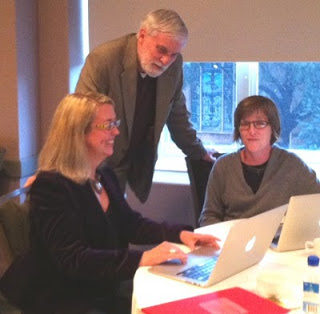
Today’s guest post is by Lisa Eriksen, an independent consultant to museums, artists, and cultural organizations. Previously, Lisa was the director of education and public programs at the California Historical Society. Lisa is blogging this week from the Houston Future Studies certificate course—the one I took last year.
This Monday, I learned about multiple futures, change, and that eras are ended by discontinuity. Last May, a new era in my career began when I was invited to participate in the workshop “Forecasting the Future of California Museums” at the American Association of Museums Annual Meeting. My thanks to Celeste DeWald, executive director of the California Association for Museums, and Elizabeth Merritt, founding director of AAM’s the Center for the Future of Museums for including me in this enlightening workshop and helping set me on the road to a “transformative transition” in my career.
Before the CFM/CAM workshop, I was aware of field of futures studies, but never thought deeply about it could be applied to my work with museums. I had dabbled in foresight in my leisure reading and online adventures. On the wall of my office is a printout of the Trends and Technology Timeline 2010+ from Richard Watson’s website, which I find fascinating. When I discovered there was a 5-day Strategic Foresight certificate program offered at the University of Houston I thought this is for me, and here I am in Houston!
 The first day of the course was a fascinating introduction to the practice of futures studies and how to analyze change and systems. A few snippets we learned are that no one can predict the future, but that “the trick of being a futurist is to always be thinking of multiple futures.” The present may or may not singular, but the future is multiple, there are many possible futures that we need to consider. Futures studies (note the use of the plural) is academic term, whereas strategic foresight is used more often in professional context. Change can be both viewed as inbound (what happens to us) or outbound (the change we create) – the future is a combination of both. Professor Peter Bishop recommends that we create organizations where people are rewarded for bringing in ideas about the future from outside, no matter how irrelevant. Eventually, one of these ideas will be important in planning for future change. Assumptions, which are often viewed negatively, are useful in considering beliefs and values in forecasting the future. We need to challenge assumptions and stress testing for uncertainty.
The first day of the course was a fascinating introduction to the practice of futures studies and how to analyze change and systems. A few snippets we learned are that no one can predict the future, but that “the trick of being a futurist is to always be thinking of multiple futures.” The present may or may not singular, but the future is multiple, there are many possible futures that we need to consider. Futures studies (note the use of the plural) is academic term, whereas strategic foresight is used more often in professional context. Change can be both viewed as inbound (what happens to us) or outbound (the change we create) – the future is a combination of both. Professor Peter Bishop recommends that we create organizations where people are rewarded for bringing in ideas about the future from outside, no matter how irrelevant. Eventually, one of these ideas will be important in planning for future change. Assumptions, which are often viewed negatively, are useful in considering beliefs and values in forecasting the future. We need to challenge assumptions and stress testing for uncertainty.
In attendance are 35 individuals who came from as Perth, Australia and Trinidad and Tobago. We have an economist/city planner, a life coach, a non-profit marketing consultant, an engineer, people working for technology companies and in tourism, a number of people from various branches the military, and many others I have not met yet. I am not sure which I am enjoying more, the instruction or the engaging dialogue I am having with my fellow students. My mind is full of new ideas and I already have a cadre of fellow futurists-in-training to share ideas with.Now on to a whole week of finding foresight!
Interested in starting your own training as a futurist? Join us at the AAM Annual Meeting in Houston for a day-long forecasting workshop co-taught by professional futurist Garry Golden of Oliver Kaizen and me (Elizabeth Merritt). AAM members can register for the annual meeting by Feb. 18 for the Early Bird rate—just $375. Not a member? Join now to get this special rate!








